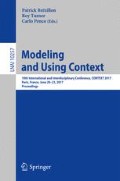Abstract
With the growing number of users and the huge amount of information in dynamic social networks, contextualizing community detection has been a challenging task. Thus, modeling these social networks is a key issue for the process of contextualized community detection. In this work, we propose a temporal multiplex information graph-based model to represent dynamic social networks: we consider simultaneously the social network dynamicity, its structure (different social connections) and various members’ profiles so as to calculate similarities between “nodes” in each specific context. Finally a comparative study on a real social network shows the efficiency of our approach and illustrates practical uses.
Access this chapter
Tax calculation will be finalised at checkout
Purchases are for personal use only
References
Milioris, D.: Trend Detection and Information Propagation in Dynamic Social Networks. Doctoral dissertation, École Polytechnique (2015)
Barabâsi, A.L., Jeong, H., Néda, Z., Ravasz, E., Schubert, A., Vicsek, T.: Evolution of the social network of scientific collaborations. Phys. A: Stat. Mech. Appl. 311(3), 590–614 (2002)
Plantié, M., Crampes, M.: Survey on social community detection. In: Ramzan, N., van Zwol, R., Lee, J.-S., Clüver, K., Hua, X.-S. (eds.) Social Media Retrieval, pp. 65–85. Springer, Heidelberg (2013)
Newman, M.E.J.: Networks: An Introduction, 1st edn. Oxford University Press, Oxford (2010)
Psorakis, I., Roberts, S.J., Rezek, I., Sheldon, B.C.: Inferring social network structure in ecological systems from spatio-temporal data streams. J. R. Soc. Interface 9, 1–10 (2012). rsif2012022
Ford, D.A., Kaufman, J.H., Mesika, Y.: Modeling in space and time. In: Castillo-Chavez, C., Chen, H., Lober, W.B., Thurmond, M., Zeng, D. (eds.) Infectious Disease Informatics and Biosurveillance, vol. 27, pp. 191–206. Springer, Berlin (2011)
Xu, A., Zheng, X.: Dynamic social network analysis using latent space model and an integrated clustering algorithm. In: Eighth IEEE International Conference on Dependable, Autonomic and Secure Computing, DASC 2009, pp. 620–625. IEEE (2009)
Ngonmang, B., Viennet, E.: Dynamique des communautés par prédiction d’interactions dans les réseaux sociaux. EGC, 553–556 (2014)
Aynaud, T., Guillaume, J.-L.: Multi-step community detection and hierarchical time segmentation in evolving networks. In: Fifth SNA-KDD Workshop Social Network Mining and Analysis, in Conjunction with the 17th ACM SIGKDD International Conference on Knowledge Discovery and Data Mining, KDD (2011)
Lancichinetti, A., Fortunato, S., Kertész, J.: Detecting the overlapping and hierarchical community structure in complex networks. New J. Phys. 11(3), 033015 (2009)
Girvan, M., Newman, M.E.J.: Community structure in social and biological networks. Proc. Nat. Acad. Sci. U.S.A. 99(12), 7821–7826 (2002)
Fortunato, S.: Community detection in graphs. Phys. Rep. 486(3–5), 103 (2009)
Zimmermann, A., Lorenz, A., Oppermann, R.: An operational definition of context. In: Kokinov, B., Richardson, D.C., Roth-Berghofer, T.R., Vieu, L. (eds.) CONTEXT 2007. LNCS (LNAI), vol. 4635, pp. 558–571. Springer, Heidelberg (2007). doi:10.1007/978-3-540-74255-5_42
Zainol, Z., Nakata, K.: Generic context ontology modelling: a review and framework. In: 2nd International Conference on Computer Technology and Development (ICCTD), pp. 126–130. IEEE (2010)
Dey, A.K.: Understanding and using context. Pers. Ubiquit. Comput. 5(1), 4–7 (2001)
Newman, M.E.J., Girvan, M.: Finding and evaluating community structure in networks. J. Phys. Rev. 69(2), 026113 (2004)
Blondel, V., Guillaume, J.-L., Lambiotte, R., Lefebvre, E.: Fast unfolding of communities in large networks. J. Stat. Mech.: Theory Exp. 2008(10), P10008 (2008)
Kim, J., Lee, J.G.: Community detection in multi-layer graphs: a survey. ACM SIGMOD Rec. 44(3), 37–48 (2015)
Moser, F., Ge, R., Ester, M.: Joint cluster analysis of attribute and relationship data without a-priori specification of the number of clusters. In: Dans Proceedings of the 13th ACM SIGKDD International Conference on Knowledge Discovery and Data Mining, pp. 510–519 (2007)
Combe, D.: Détection de communautés dans les réseaux d’information utilisant liens et attributs (2013)
Kanawati, R.: Détection de communautés dans les grands graphes d’interactions (multiplexes): état de l’art (2013)
Boccaletti, S., Bianconi, G., Criado, R., Del Genio, C.I., Gómez-Gardeñes, J., Romance, M., Sendiña-Nadal, I., Wang, Z., Zanin, M.: The structure and dynamics of multilayer networks. Phys. Rep. 544(1), 1–122 (2014)
Kanawati, R.: Co-authorship link prediction in multiplex bibliographical networks. In: Multiplex Network Workshop - European Conference on Complex Systems (ECCS 2013) (2013)
Nguyen, N., Dinh, T., Xuan, Y., Thai, M.: Adaptive algorithms for detecting community structure in dynamic social networks. In: 2011 Proceedings of IEEE INFOCOM, pp. 2282–2290 (2011)
Ben Yahia, N., Bellamine, N., Ben Ghezala, H.: Community-based collaboration recommendation to support mixed decision making support. J. Decis. Syst. 23(3), 350–371 (2014)
Lebart, L., Maurineau, A., Piron, M.: Traitement des données statistiques. Dunod, Paris (1982)
Mucha, P.J., Richardson, T., Macon, K., Porter, M.A., Onnela, J.P.: Community structure in time-dependent, multiscale, and multiplex networks. science 328(5980), 876–878 (2010)
Author information
Authors and Affiliations
Corresponding author
Editor information
Editors and Affiliations
Rights and permissions
Copyright information
© 2017 Springer International Publishing AG
About this paper
Cite this paper
Rebhi, W., Yahia, N.B., Saoud, N.B.B., Hanachi, C. (2017). Towards Contextualizing Community Detection in Dynamic Social Networks. In: Brézillon, P., Turner, R., Penco, C. (eds) Modeling and Using Context. CONTEXT 2017. Lecture Notes in Computer Science(), vol 10257. Springer, Cham. https://doi.org/10.1007/978-3-319-57837-8_26
Download citation
DOI: https://doi.org/10.1007/978-3-319-57837-8_26
Published:
Publisher Name: Springer, Cham
Print ISBN: 978-3-319-57836-1
Online ISBN: 978-3-319-57837-8
eBook Packages: Computer ScienceComputer Science (R0)

